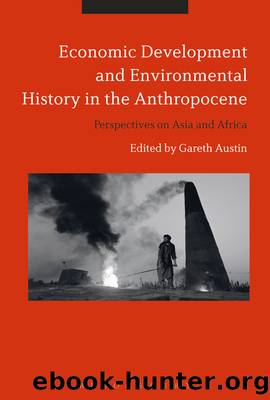Economic Development and Environmental History in the Anthropocene by Gareth Austin

Author:Gareth Austin
Language: eng
Format: epub
Publisher: Bloomsbury UK
The concept of carrying capacity
In the 1990s, a series of works appeared in ecological economics that made use of time-sensitive concepts, especially the Environmental Kuznets Curve (EKC), and carrying capacity (Arrow et al. 1995; Stern, Common and Barber 1996). Although a historical concept in principle, EKC did not make ecologists or economists take much notice of economic history, but the potential for a dialogue was created.
Carrying capacity is defined broadly as the scale of human activity that a given natural resource endowment can sustain before it starts to degrade or deplete in the course of use. The EKC predicts an initially positive statistical relationship between average income (economic growth/change) and environmental degradation, the slope reflecting the resource-use-bias of rapid development and perhaps poor institutional safeguards against overuse. Carrying capacity indirectly shows how far the EKCâs upward phase can carry on without serious societal problems. The former has never been easy to implement statistically except with few emission agents, and the latter has remained a tool for ordering thought rather than a tool for policy. In either case, scholarship using or testing these ideas rarely showed an interest in national, even global, economic history, and remained planetary and ecological in scope.
More narrowly, the carrying capacity of an agrarian ecosystem (mainly soil and water, but also climate) is the scale of human and animal life it can sustain without being degraded in the process of agricultural use (Daily and Ehrlich 1992). The carrying capacity is approached with population growth, increasing trade and rise in consumption. And carrying capacity can be raised if agricultural technology changes and production becomes more efficient. These influences interact between themselves. For example, technological change is often the cause of degradation and depletion of resources. This is so because technologies can be inherently resource intensive, for example, Green Revolution technology is intensive in the use of groundwater. Technology can also induce environmental degradation because rapid productivity gains can set off price and income effects that increase consumption, change lifestyles and put further pressure on resources (Rees 1996).
Carrying capacity is clearly a useful concept for economic history. The concept âkicks inâ when exogenous factors such as technology, trade, consumption and population growth induce a rise in agricultural production and the productivity of land. This starting phase has been described by Hla Myint in the context of nineteenth-century tropical export economies as a âvent for surplusâ pattern of economic growth, one in which natural resources are available in abundance, that is are cheap to use and can sustain an export-led growth (Myint 1958).2 Myntâs notion does not admit of environmental costs. The way to include them is through carrying capacity. As the growth process continues, the carrying capacity is reached, and degradation of the quality of soil and water could begin. That does not necessarily stop economic growth. But if these degradations are of a serious order, we operate in a phase of history in which environmental degradation can begin to adversely affect production possibilities or human welfare.
The arrangement of
Download
This site does not store any files on its server. We only index and link to content provided by other sites. Please contact the content providers to delete copyright contents if any and email us, we'll remove relevant links or contents immediately.
Zero to IPO: Over $1 Trillion of Actionable Advice from the World's Most Successful Entrepreneurs by Frederic Kerrest(4301)
Machine Learning at Scale with H2O by Gregory Keys | David Whiting(4190)
Never by Ken Follett(3797)
Harry Potter and the Goblet Of Fire by J.K. Rowling(3776)
Ogilvy on Advertising by David Ogilvy(3515)
Shadow of Night by Deborah Harkness(3306)
The Man Who Died Twice by Richard Osman(2997)
Book of Life by Deborah Harkness(2869)
The Tipping Point by Malcolm Gladwell(2828)
Will by Will Smith(2794)
0041152001443424520 .pdf by Unknown(2785)
My Brilliant Friend by Elena Ferrante(2776)
How Proust Can Change Your Life by Alain De Botton(2745)
Purple Hibiscus by Chimamanda Ngozi Adichie(2652)
How to Pay Zero Taxes, 2018 by Jeff A. Schnepper(2602)
Hooked: A Dark, Contemporary Romance (Never After Series) by Emily McIntire(2502)
Rationality by Steven Pinker(2291)
Borders by unknow(2232)
Can't Hurt Me: Master Your Mind and Defy the Odds - Clean Edition by David Goggins(2229)
